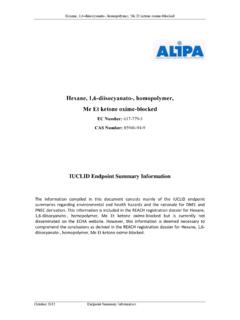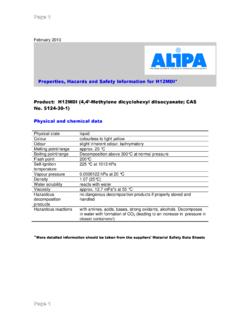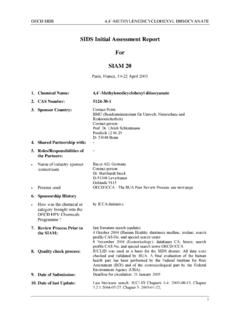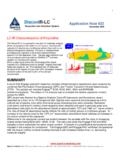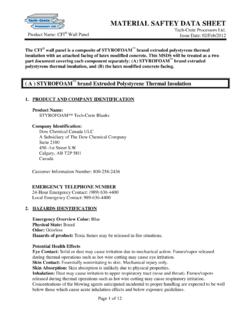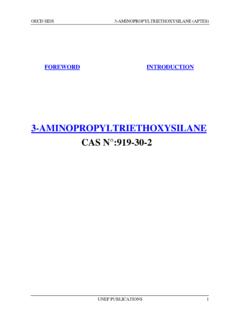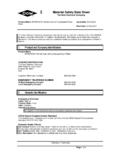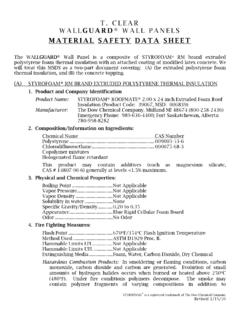Transcription of IUCLID Endpoint Summary Information - ALIPA
1 3-Isocyanatomethyl-3,5,5-trimethylcycloh exyl isocyanate homopolymer, isocyanurate type (IPDI homopolymer) EC Number: 500-125-5 CAS Number: 53380-05-0 IUPAC name: 3-Isocyanatomethyl-3,5,5-trimethylcycloh exyl isocyanate homopolymer, isocyanurate type IUCLID Endpoint Summary Information The Information compiled in this document consists mainly of the IUCLID Endpoint summaries regarding environmental and health hazards and the rationale for DNEL and PNEC derivation. This Information is included in the REACH registration dossier for 3-Isocyanatomethyl-3,5,5-trimethylcycloh exyl isocyanate homopolymer, isocyanurate type (IPDI homopolymer) but is currently not disseminated on the ECHA website.
2 However, this Information is deemed necessary to comprehend the conclusions as derived in the REACH registration dossier for 3-Isocyanatomethyl-3,5,5-trimethylcycloh exyl isocyanate homopoly-mer, isocyanurate type. EC Number: 500-125-5 3-Isocyanatomethyl-3,5,5-trimethylcycloh exyl isocyanate homopolymer, isocyanurate type CAS No.: 53880-05-0 December 2011 Endpoint Summary Information 2 Table of Contents 1. PHYSICAL AND CHEMICAL PROPERTIES .. 4 2. ENVIRONMENTAL FATE PROPERTIES .. 5 Hydrolysis .. 5 Phototransformation in air .. 5 Biodegradation .. 6 Biodegradation in water and sediment .. 6 Biodegradation in soil .. 6 Summary and discussion of degradation.
3 6 Environmental distribution .. 7 Adsorption/desorption .. 7 Volatilisation .. 7 Summary and discussion of environmental distribution .. 7 Bioaccumulation .. 7 3. ENVIRONMENTAL HAZARD ASSESSMENT .. 9 Aquatic compartment (including sediment) .. 9 Toxicity test results .. 9 Short-term toxicity to fish .. 9 Long-term toxicity to fish .. 9 Short-term toxicity to aquatic invertebrates .. 9 Long-term toxicity to aquatic invertebrates .. 10 Algae and aquatic plants .. 10 Sediment organisms .. 10 Predicted No Effect Concentration (PNEC) .. 11 Terrestrial compartment .. 12 Toxicity to soil macro-organisms .. 12 Toxicity to terrestrial plants .. 12 Toxicity to soil micro-organisms.
4 13 Predicted No Effect Concentration (PNEC soil) .. 13 Atmospheric compartment .. 13 Microbiological activity in sewage treatment systems .. 13 Toxicity to aquatic micro-organisms .. 13 PNEC for sewage treatment plant .. 14 Non compartment specific effects relevant for the food chain (secondary poisoning) .. 14 Toxicity to birds .. 14 Toxicity to mammals .. 14 PNEC oral (secondary poisoning) .. 14 Conclusion on the environmental hazard assessment and on classification and labelling .. 15 4. HUMAN HEALTH HAZARD ASSESSMENT .. 16 Toxicokinetics (absorption, metabolism, distribution and elimination) .. 16 Acute toxicity .. 16 Irritation .. 17 Sensitisation.
5 18 Repeated dose toxicity .. 19 Mutagenicity .. 19 Carcinogenicity .. 20 Toxicity for reproduction .. 20 Effects on fertility .. 20 Developmental toxicity .. 20 Summary and discussion of reproductive toxicity .. 21 Derivation of DNEL(s) / DMEL(s) .. 23 5. HUMAN HEALTH HAZARD ASSESSMENT OF PHYSICO-CHEMICAL PROPERTIES .. 26 Explosivity .. 26 Flammability .. 26 Oxidising potential .. 26 6. PBT AND VPVB ASSESSMENT .. 27 Assessment of PBT/vPvB Properties - Comparison with the Criteria of Annex XIII .. 27 3-Isocyanatomethyl-3,5,5-trimethylcycloh exyl isocyanate homopolymer, isocyanurate type CAS No. 53880-05-0 IUCLID Endpoint Summary Information Persistence Assessment.
6 27 Bioaccumulation Assessment .. 27 Toxicity Assessment .. 28 Summary and overall conclusions on PBT or vPvB properties .. 28 Emission Characterisation .. 28 7. REFERENCES .. 29 EC Number: 500-125-5 3-Isocyanatomethyl-3,5,5-trimethylcycloh exyl isocyanate homopolymer, isocyanurate type CAS No.: 53880-05-0 December 2011 Endpoint Summary Information 41. PHYSICAL AND CHEMICAL PROPERTIES Molucular weight range: >= g/mol Molecular formula: residual C12H18N2O2, otherwise C36H54N6O6 (trimer) and higher species Appearance/physical state/colour: Transparent to white solid (pellets) Melting / freezing point: The melting temperature of isophorone diisocyanate homopolymer was determined by differential scanning calorimetry.
7 The melting temperature is C (976 hPa). Additional studies show that this is not a melting point but an enthalpy relaxation because the substance is not crystalline. Boiling point: No boiling point was found prior to decomposition (beginning at approx. 347 C; hPa). Therefore, a boiling point could not be determined. Relative density: g/cm3 at 20 C Vapour pressure: *10-09 Pa at 20 C. (Indications of decomposition at the highest temperatures were observed.) Water solubility: The substance is hydrolytically unstable at pH 4, 7 and 9 (half-life less than 12 hours). Partition coefficient n-octanol/water (log value): The following properties of the substance make the study technically not feasible: (1) The water solubility is very low.
8 (2) The substance reacts with water (half-life < 12 hours at room temperature). (3) Appropriate analytical methods are not available. The fact that the substance is a mixture increases the analytical difficulties. Flash point: The substance is a solid melting above 60 C. Therefore, the study is technically not feasible. Flammability: 3-Isocyanatomethyl-3,5,5-trimethylcyclo- hexylisocyanate homopolymer is not highly flammable according to the definition in the Council Regulation (EC) No 440/2008, method Explosive properties: As 3-isocyanatomethyl-3,5,5-trimethylcyclo- hexylisocyanate homopolymer was neither shock sensitive nor thermally or friction sensitive, according to the criteria of the EC test method of Council Regulation (EC) No 440/2008 it is not representing an explosive hazard and has not to be considered to present a danger of explosion.
9 Self-ignition temperature: The substance is a solid with a melting point 160 C. Therefore, a test is not required. Oxidising properties: Based on the chemical structure, the substance is incapable of reacting exothermically with combustible materials. Stability in organic solvents: The stability of the substance in aprotic organic solvents is not considered to be critical. Dissociation constant: The substance is hydrolytically unstable (half-life less than 12 hours). Therefore, a test is not required according to REACH Annex IX, , column 2. Viscosity: The substance is a solid. Viscosity can only be measured for liquids. 3-Isocyanatomethyl-3,5,5-trimethylcycloh exyl isocyanate homopolymer, isocyanurate type CAS No.
10 53880-05-0 IUCLID Endpoint Summary Information 52. ENVIRONMENTAL FATE PROPERTIES General discussion of environmental fate and pathways: Regarding the environmental fate and pathways there are only few data available. The substance has a high reactivity towards OH radicals in the atmosphere and hydrolyses rapidly, but it is not readily biodegradable in aqueous systems. As no biodegradation (0%) was observed in a study on ready biodegradability, it is not expected that a significant degradation would occur in a simulation test. The test substance is considered as non-biodegradable in surface water and sediment compartment. Moreover, biodegradation is irrelevant as primary degradation step because immediate hydrolysis takes place.
